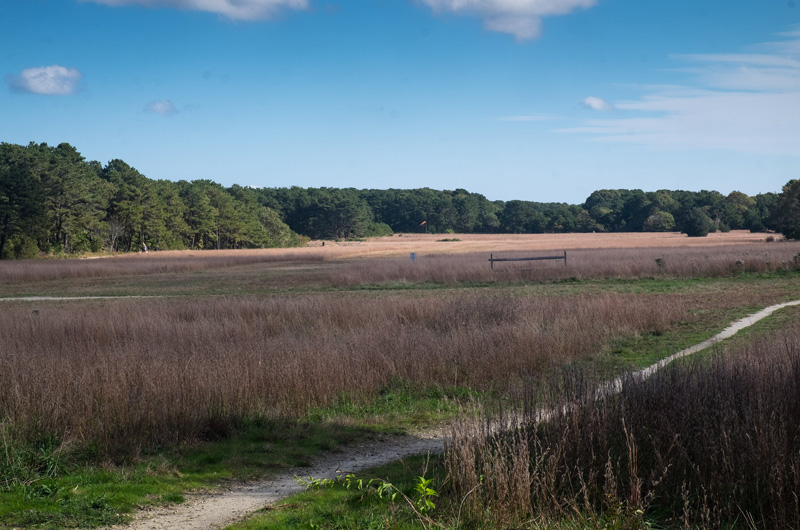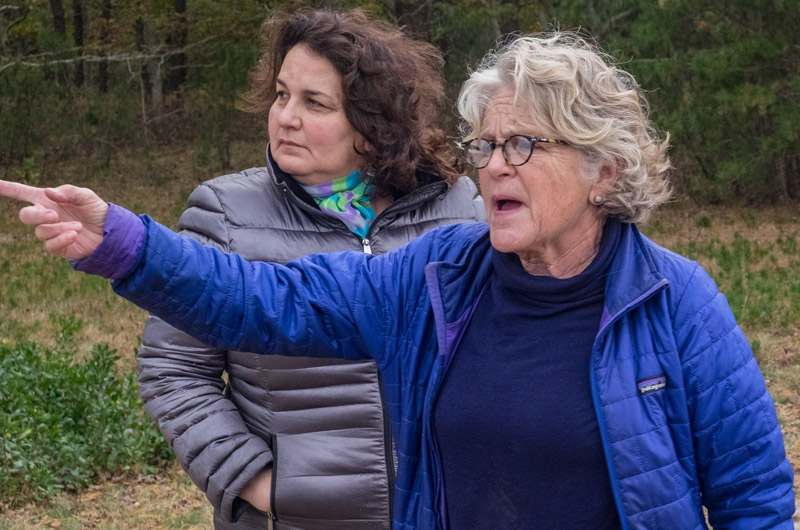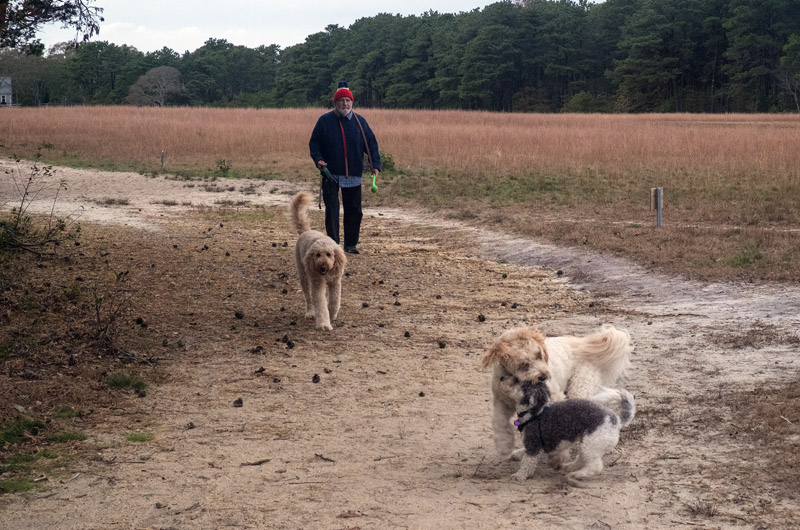A simmering dispute between the Martha’s Vineyard Land Bank and devoted users of one of its properties has come to a head this fall with the land bank’s plan to fence off a large field at the Trade Wind Fields Preserve in Oak Bluffs.
The fence is the latest step in what the land bank said is an effort to protect a sandplain grassland at the field, which has been trampled by too many walkers. The goal is to protect the land and the plants and insects that live there, land bank ecologist Julie Russell said.
But a group of Trade Wind regulars said the plan has pitted the land bank’s ecological goals against property users. They said the fence would change the aesthetics of the open field and prevent older or mobility-impaired walkers from reaching far parts of the property.
“It’s a really big gathering spot. People are so willing to accommodate whatever the land bank wants,” said Rose Cecil, a longtime regular visitor of the property who walks there with her Scottish terriers, Igor and Bunny. “I’m really afraid of losing it and losing the companionship that people get from being there,” she said, adding: “I don’t think it’s just ecology versus people. To me it seems like they really just want us out of there.”

The land bank plan calls for building a four-foot-high, 1.4-mile fence made of wire and wooden posts around the perimeter of an open field at the 72-acre preserve. The land is also a seldom-used airfield. People will not be allowed to walk inside the fence.
The fence proposal was approved late last spring by the land bank commission, a Trade Winds Field Preserve aviation committee, and the Oak Bluffs land bank advisory board.
Minutes from the June 6 town advisory board meeting show the vote was 3-0, with one member abstaining. Three members were absent. During discussion, board members said they were disappointed at the need to build the fence but also were discouraged by what was characterized as misuse and misbehavior at the property.
Meeting minutes also indicated that land bank staff would remove stacks of portable chairs at the property, and wooden benches would be installed.
“We’ve been trying for years to be creative and come up with ways to protect the grasslands and plants living there, especially ones that are rare,” Ms. Russell told the Gazette this week.
Signs, closing off paths and discussion have not worked, she said. Meanwhile, repeated use has led to devegetation. Rare species found at the field include purple tiger beetles, and rare plants include blue-eyed grass, purple needlegrass and New England blazing star, Ms. Russell said. “It’s been years of trying different things and now we’re at the point where we’ve run out of things to try,” she said.

The fence is still pending approval by the Natural Heritage and Endangered Species program. Ms. Russell said the land bank hopes to install it by the end of the year.
She said the fence would be minimally invasive and compared it to fences at the Katama Airfield in Edgartown.
“It’s just hard for people to really get their heads around grasslands and sandplain grasslands,” Ms. Russell said. “I really wish that they were staying on the trail. The habitat is pretty because of all the things in there . . . and that’s what we are trying to protect.”
Land bank executive director James Lengyel said the fence aligns with the land bank’s top goal: environmental protection. “Environmental protection leads the list of land bank goals with public use encouraged where and when possible,” he said, quoting the mission statement that appears on the land bank map.
“That says it all,” he added. “That’s three decades worth of philosophy.”
Mr. Lengyel said about $25,000 is set aside in the land bank budget for the fencing project.
Meanwhile, Trade Wind regulars are dug in with their opposition to the fence. As of early Thursday afternoon, 279 people had signed a “Fight the Fence” petition posted online on Oct. 24. A notice about the petition was also posted at the entrance to the preserve this week.
And while many know Trade Wind as a dog park — it is a popular spot for dog walkers — others said human companionship is the driving force behind their fondness for the area. Visitors include older and mobility-challenged people, in addition to joggers, walkers and others. Stations that allow people to clean up after their dogs have been added and largely complied with, regulars said, and the paths across the field are largely used by people who cannot walk the entire perimeter of the property.
This week a stack of green plastic chairs sat near where a wooded trail connects the parking lot to the grass field. The chairs were purchased a few years ago after a regular visitor had a heart attack and wanted a supportive seat so he could visit the field during his recovery, Ms. Cecil said as her dogs sniffed and played in the dirt. The walk from the parking lot would be hard to navigate while carrying a chair, she added, and wooden benches are not comfortable for older people. She said she found the effort to remove the chairs mean spirited.
She gestured to a short fir tree nearby. “This is our Charlie Brown Christmas tree,” she said, noting that every year the Trade Wind regulars have a party and decorate the tree.
Ms. Cecil said regular visitors care about the property and have largely succeeded at helping bring back the grass field by restricting themselves to certain paths. But she said park users were not included in the management plan process, and instead were treated like “vandals.”
“We just don’t know why they really want to get rid of us,” Ms. Cecil said. “They could figure something out that works for us and them.”
Idalyn Gilstad, another regular who was keeping an eye on her dog Lily, said the land bank is straddling two worlds: the property’s history as an airfield and status as conservation land. People have become the third part of the equation, she said.
“It’s the best view you can have,” Ms. Gilstad said. “Now you’ll just see wall. It will be monotonous and depressing.”
She said she plans to stop coming to the park.
Other regulars arrived, many with dogs, and gathered at the edge of the field near a well-worn cross path marked with a sign warning walkers to keep out. Dogs played while their owners chatted. Michael Chan arrived for his regular walk around the field to take pictures of mushrooms.
Oak Bluffs resident Mark Jenkins said concerns about the fence come from people who use the preserve in a variety of ways, not just dog walkers. “There’s a groundswell of support to oppose this,” he said. “It’s a shame that the land bank feels they need to move forward with this.”
Mr. Jenkins said he supports the land bank and its mission, but he said the fence goes against the property management plan, which partly calls for maintaining attractive views.
“This is to show that they basically can do whatever they want to do,” he said of the land bank’s approach. “Doing something that’s really aggressive . . . do we want one of the most beautiful parts of the Island, and certainly one of the most special parts of Oak Bluffs, inflicted with this 1.4-mile long steel-mesh fence, that’s the question.”
“It would be a disaster,” said Marsha Eldredge said as she stood at the edge of the large grass field this week. “Who would want to look at this and see wire and posts?”








Comments (20)
Comments
Comment policy »